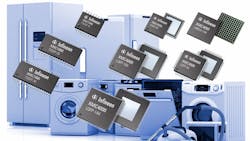Microcontroller Test Library Keeps The Kitchen Safe
The Class B element of the German VDE-certified IEC 60730 standard impinges on all electronic controls used in home appliances. Its primary mandate is to prevent unsafe operation of cookers and motor controls for dishwashers, refrigerators, dryers, washing machines, and fans. The mandatory standard for the safety of European-sold household appliances was put into effect in October 2007.
VDE, which stands for the German Association for Electrical, Electronic and Information Technologies, is one of Europe’s largest technical and scientific associations with more than 36,000 members. It serves an independent test and certification institute.
To get household products certified, designers must perform a variety of self-tests on embedded microcontrollers to validate that they’re running correctly at all times. Only then will household appliances receive certification.
On that front, Infineon offers a free IEC 6073 self-test library for its XMC1000 and XMC4000 families of industrial 32-bit microcontrollers (see the figure). The XMC microcontrollers integrate all hardware functions to meet Class B requirements, such as a cyclic-redundancy-check (CRC) engine and watchdog with an independent clock.
Error-Detecting Code
The CRC is error-detecting code that’s often employed in digital networks and storage devices to detect accidental changes to raw data. A short check value, based on the remainder of a polynomial division of the contents, is attached to the data entering these systems. On retrieval, the calculation is repeated; if the check values do not match, then corrective action can instigate against presumed data corruption.
CRCs are so called because the check (data verification) value is a redundancy (it expands the message without adding information) and the algorithm is based on cyclic codes. CRCs offer several distinct advantages: they’re simple to implement in binary hardware, easy to analyze mathematically, and particularly good at detecting common errors caused by noise in transmission channels. Due to the check value’s fixed length, the function that generates the check value is occasionally used as a hash function.
Self-Test Software
By combining these tests with the free self-test software library, Infineon believes its XMC microcontrollers provide an effective approach to implementing safety functions relative to Class B certification. In addition to the startup tests—reset mechanism, memory test (RAM, flash, ECC, and parity), clock system test (source, PLL and oscillators), and core tests—there’s a full set of runtime tests.
As a result, this will ensure test routines on the CPU and microcontroller peripherals achieve Class B requirements. In addition, modular library design simplifies integration of startup tests and runtime tests into the application software or the customers’ software designs.
Infineon claims the XMC microcontrollers, which are intended to replace low-end 8-bit industrial MCUs, deliver 32-bit performance at 8-bit prices. Target applications include sensor and actuator systems, LED lighting, digital power conversion (e.g., uninterruptible power supplies), and simple motor drives for household appliances, pumps, fans, e-bikes, etc.
The ARM Cortex-M4-based XMC4000 microcontrollers offer application-optimized peripherals and real-time capability for electric drives, solar inverters, and the automation of manufacturing and buildings. They’re supported by the DAVE integrated development platform, which facilitates development of application software and eases transition between the XMC1000 and XMC4000 families.
The DAVE platform, an Eclipse-based software development platform, includes a free tool-chain and supports automatic code generation. Thus, it simplifies use of predefined and tested software components, otherwise known as “DAVE Apps.”
In contrast to commonly used tools that offer libraries and code examples, the DAVE Apps are more abstract, allow graphical combination of several DAVE Apps, and enable automatic, conflict-free mapping to the chip’s available hardware resources.
Coupled with the current-version DAVE 3 are the first 28 DAVE Apps. These support Ethernet, TCP-IP and file system applications, and data-integrity and encryption/decryption solutions. The DAVE Apps also include PWM-generation support, various counter and timer use cases, clock configuration, interrupt handling, and direct-memory-access (DMA) configuration.
This open platform enables flexible extensions and adaptations. In addition to the free compiler, linker, debugger, and flash loader, it offers plug-ins from commercial tool vendors.
